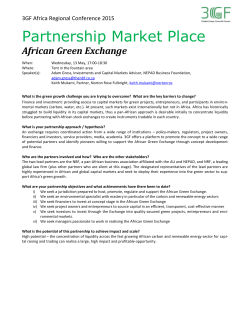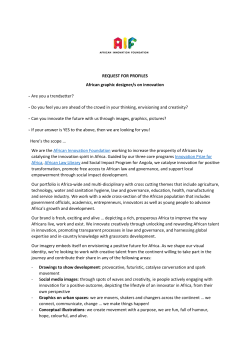
Marketing South African products in Africa Manufacturing Indaba
Marketing South African products in Africa Manufacturing Indaba Newsletter – March 2015 With growth rates exceeding those in the developed world – at an average of between 4 and 5% between 2002 and 2014 - Africa is providing investors with ample reason to tap into its booming consumer demand. With relative ease of access to sub-Saharan Africa and beyond, and an understanding of the region, South African manufacturers can get ahead of other investors looking to Africa for new opportunities. The World Bank reported in April 2014 in Africa’s Pulse - its twice-yearly analysis of the issues shaping Africa’s economic prospects - that strong investment growth and household spending is being seen in Sub-Saharan Africa. “Economic growth in Sub-Saharan Africa (SSA) continues to rise from 4.7 percent in 2013 to a forecasted 5.2 percent in 2014. This performance is boosted by rising investment in natural resources and infrastructure, and strong household spending.” Capital flows to Sub-Saharan Africa continued to rise, reaching an estimated 5.3 percent of regional GDP in 2013, significantly above the developing-country average of 3.9 percent. Net foreign direct investment (FDI) inflows to the region grew 16 percent to a near-record $43 billion in 2013, boosted by new oil and gas discoveries in many countries including Angola, Mozambique, and Tanzania, the analysis says. In addition to this, research firm McKinsey & Company stated in 2010 that rising incomes and an underdeveloped retail sector have made Africa an important new growth destination for retailers and consumer goods companies, with companies like Danone, Pernod Ricard and Diageo boosting investments in the region to counter their weak growth in Europe. Africa's prospects for retailers came to the fore in 2011 when American giant Wal-Mart bought a majority stake in South Africa's Massmart, gaining a foothold in several frontier markets. Though African per capita incomes are among the lowest in the world, a decade of robust growth and rapid population expansion has attracted international investor attention. McKinsey research shows that the number of African households with discretionary income is projected to rise by 50 percent over the next 10 years to 2024, reaching 128 million. In particular, Africa represents a large and growing opportunity for fast-moving consumer goods companies and retailers and the rapid expansion of its consumer class should convince companies to think differently about Africa. In 2010, McKinsey forecast total growth in compound annual GDP per capita of 4.5 percent until 2015, which they said would boost consumer spending by more than 35 percent. “With population growth of 2 percent and continued urbanization, we estimate that 221 million basicneeds consumers will enter the African market by 2015. As a result, the total number of nations with more than ten million consumers and with gross national income exceeding $10 billion a year will increase to 30 from 22.” The current economic conditions in Africa make it the prime place and time for South African manufacturers to introduce their products to the African market. “GDP per capita is the single most important driver of global growth in the consumption of fastmoving consumer goods, accounting for an average of around 73 percent of total growth across 60 product categories.” While the influence of other factors, such as education and local customs, varies between categories, GDP per capita dominates how much money people spend in Africa because most markets are in the early stages of development. As a result, product-category growth of fastmoving consumer goods typically follows a classic S-curve. McKinsey’s research in 2010 was done to assist companies in determining which product strategy would work best at a particular time in a particular African country. But it’s critical that manufacturers move swiftly to maximise the African opportunity. “Africa presents a solid opportunity for producers and retailers of fast-moving consumer goods but requires strategies tailored and executed market-by-market to account for different rates of economic growth and local consumer needs and preferences. In addition, speed is very important. Companies that can quickly establish a foothold or expand their presence will be well positioned to capture the value at stake as the continent’s consumers increase their spending in the years to come.” Sources: CFAO taps five French retail brands for its African mall push | Reuters Feed http://www.theafricareport.com/ Picking products for Africa’s growing consumer markets June 2010 | byEirini Drakaki, Udo Kopka, and Taro Nordheider http://www.mckinsey.com/insights/consumer_and_retail/the_rise_of_the_african_consumer Africa’s Growth Set to Reach 5.2 percent in 2014 With Strong Investment Growth and Household Spending http://www.worldbank.org/en/news/press-release/2014/04/07/africas-growth-set-to-reach-52-percent-in-2014with-strong-investment-growth-and-household-spending
© Copyright 2025









